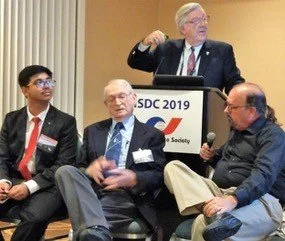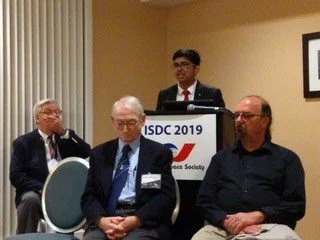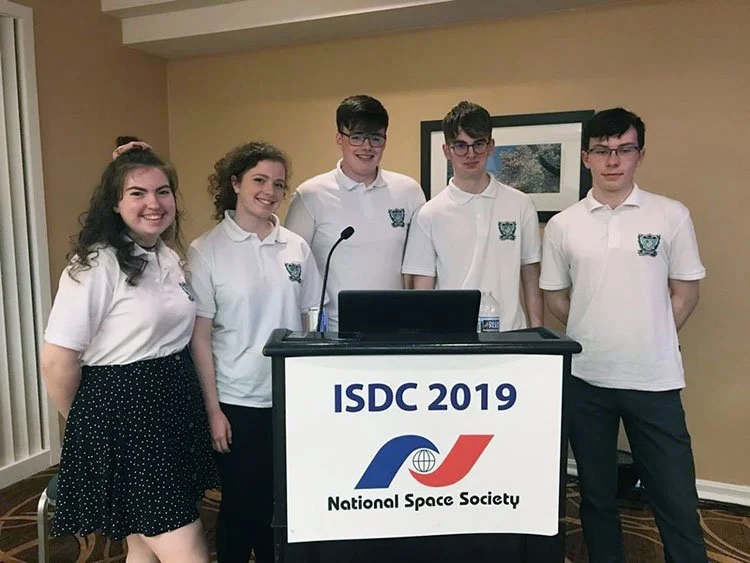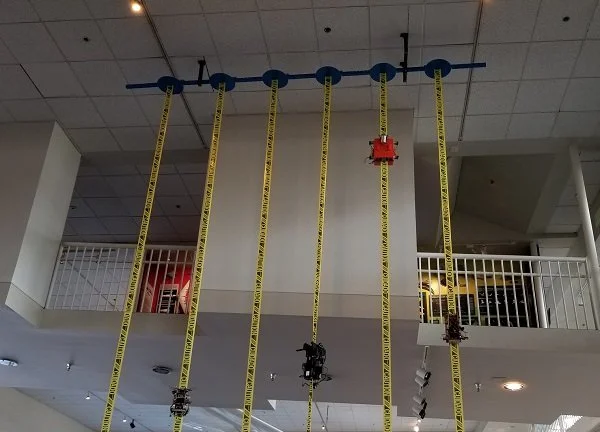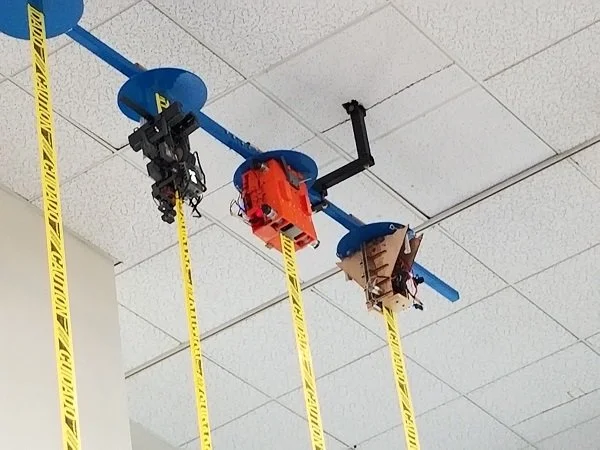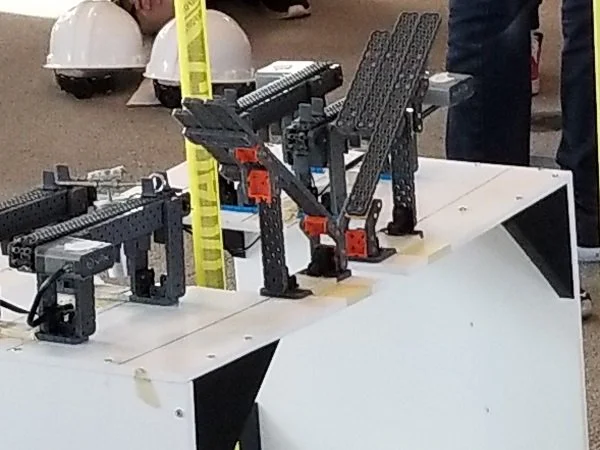International Space Elevator Consortium
July 2019 Newsletter
In this Issue:
Editor’s Note
President’s Corner
ISEC at ISDC
Robotics Competition
ISEC Space Elevator Conference
Upcoming Events
Editor’s Note
Dear Fellow Space Elevator enthusiast,
Last month, the National Space Society held their annual International Space Development conference in Washington, D. C. The Space Elevator Track at that convention was three hours and well-represented by ISEC! Pete Swan tells us more about his experiences, below.
August 16th is a very important date...it's my birthday! And besides that, it's the first day of our annual conference. Have you purchased tickets, yet? If you haven't, or just want to know more, head to our website: https://www.isec.org/sec/.
If you don't want to attend the 3-day technical program but would like to learn more about Space Elevators, in general, consider coming to the Family Science Fest held on Saturday. There will be a climber competition in the Great Gallery and two general introductory lectures held in the The Charles Simonyi Space Gallery, a short walk via overpass, across the street. There, you will sit next to the actual full-scale mockup of the Space Elevator that was built for the Johnson Space Center! The details for the Family Science Fest are here: https://isec.org/family-science-fest-2019-space-elevator-conference.
If you would like to know more about the climber competition, see the article describing it, below.
I know I will be there, and I hope to see you there!
If you would like to follow us on Twitter, use this link! Please like us on Facebook and watch more videos on our YouTube channel. And please visit the Space Elevator home page for all things regarding ISEC for the latest information.
Thank you for your continued support of the International Space Elevator Consortium!
Sandee Schaeffer
Newsletter Editor
President's Corner
2019 - A Breakout Year
After a delightful and exciting time at the NSS International Space Development Conference in Washington DC, I am even more convinced than ever that this year is our "Breakout Year" for space elevators. We have grown significantly since the release of Dr. Edwards NAIC's Phase Two study which stated that the space elevator could be built, except they had to wait for the material to develop (in their summaries it was carbon-nanotubes). The world has progressed over 17 years and we a new the conclusion:
The Space Elevator is Closer than you Think.
There are two factors that lead to this conclusion:
The first is that the material for space elevator tethers has been discovered and is in the laboratory now. Single Crystal Graphene has been developed towards a continuous growth production concept (grow a single molecule very long - hundreds of meters) (currently at 0.5 x 0.1 meter single molecule one atom thick in laboratories). Adrian Nixon projected that future of very long molecules during his talk at our recent ISEC Webinar. The material is going to be available in the required strength and length for space elevators.
The second is that we (ISEC with the other organizations such as IAA, Obayashi Corporation, and JSEA) have conducted engineering studies and testing showing great progress across the engineering design segments of a space elevator. The following year long (IAAs and Obayashi were multi-year) studies have lead to the conclusion that the space elevator is ready to start testing the technologies needed inside each of its major segments and regions.
IAA (2014 - Space Elevator Feasibility & 2019 - Road to Space Elevator Era)
Obayashi (2014 - Space Elevator Design and follow-up analysis/papers)
ISEC (2010 - Space Elevator & Space Debris, 2012 - SE Concept of Operations, 2013 - Tether Climbers, 2014 - Architecture & Roadmaps, 2015 - SE Earth Port, Apex Anchor and GEO Node, 2016 - Software SE Simulator, 2017 - Multi-Stage SE).
These two factors have combined to lead the Space Elevator Team to start an effort where we can reach some conclusions and start the efforts necessary to depart the Technological Feasibility Phase and initiate the Engineering Validation phase with its required testing. This major step will lead us towards the destination of Galactic Harbours around the equator.
Keep Climbing my Friends,
Pete
2019 International Space Development Conference and Space Elevator Track
by Pete Swan
The excitement was contagious at this year's ISDC. Statements such as the following were made by virtually all of the leadership attendees (government, international and commercial):
"It's time to go back to the Moon, but this time to stay." Jeff Bezos (May 2019)
"This time, we will not only plant our flag and leave our footprints -- we will establish a foundation for an eventual mission to Mars, and perhaps someday worlds beyond." President Trump (Dec 2017)
The sessions ranged from our Space Elevator Track to many others such as:
The Moon
NASA Innovative Advanced Concepts, Space Settlements
Mankind's Future on Mars
Space Transportation
Space Business
Space Solar Power
In addition, there were awards and celebrations at each lunch and dinner to ensure that the tradition of "recognition of achievements" was continued. Many old friends were being recognized while new players in the space world were dreaming of their futures. The amazing environment was full of innovative thinkers from around the world with a significant attendance by students representing winners in their "Space Settlement" competitions (see separate article on the Irish students).
The contributions by our space elevator experts were significant and will establish a high standard for next year. They were: Michael Fitzgerald (Pathway to Maturity and moderator of panel), Peter Robinson (Tether Material and Tether Climber), Jerome Pearson (Keynote speaker), Peter Swan (Track Chair), James Torla (Interplanetary Flight), Panel Members (Fitzgerald, Dave Dressler, Jerome Pearson and Souvik Mukherjee).
The beauty of this conference is that there are only "Big Thinkers" attending. The ideas for the future are amazing and many attendees were excited about the space elevator's future. One of the major conclusions from our space elevator track surfaced from the suggestions, questions and persistence of the audience to recognize the space elevator as an environmentally friendly method to access space. The topic was discussed multiple times as thoughts matured and moved towards a conclusion that has been brought back by the ISEC leadership and will be developed further. The basic concept is that the space elevator is "green" and will enable the Earth's environment to become "greener." This concept will be a mini-workshop during the ISEC Space Elevator Conference in Seattle in mid-August.
All-in-all, the energy, effort, and resources to support ISEC's leadership within the Space Elevator Track have resulted in positive feedback and enthusiastic support from the attendees of this year's ISDC.
ISDC Panel 8 June 2019:
Space Elevator Mission Interplanetary Support Through Collaboration by Many
This lively panel concluded the three-hour space elevator track at the ISDC. the mission of the panel was to summarize the last few talks during the afternoon and stimulate discussions with questions from the audience. They succeeded with many of the questions demanding follow-up research to be discussed at the 2019 ISEC Space Elevator Conference (16-19 Aug Seattle).
The members of the panel were: Moderator: Michael Fitzgerald, Members (L to R) Souvik Mukherjee, Jerome Pearson, and Dave Dressler
Why are space elevators required in the future?
A view from a Teenager.
by Souvik Mukherjee
Our world is growing everyday with increasing population the demand for resources too is increasing at an exponential rate, simply speaking our planets resources will not be sufficient to help us sustain in future. Maybe non-renewable sources of can help us in the fields of energy but what will we do for land (required for living, agriculture, education, etc.), materials for building and many other things. We need to go beyond the limits of sky to planets, asteroids different galaxies to meet the next generation’s needs. For those we will need to increase our rocket launches which will later cause more air pollution and environmental issues. We need another mode of transport which is Faster, Cheaper, Safer and Environmentally Friendly and Space Elevator is the answer.
Example:
City A has resource “X” which is required by city B very badly but the road connecting them is a very bad position so it takes a lot of time to transport the material “X”. Now someone has built an express highway between the cities due to which the time taken to transport has decreased, the frequency of shipments moving has increased and many other advantages. In our case Space Elevator acts as the express highway between planets and other celestial bodies.
At podium: Souvik Mukherjee, a 16 year old Indian Student who attended the 2019 ISDC and participated in the Space Elevator Track Concluding Panel.
Students from IRELAND present their concept of space settlement within Space Elevator
During the Space Elevator Track at the ISDC, a team from St.Flannan's College, Ennis, Co. Clare, Ireland, presented their design for a space settlement. The students won third prize in the most senior category of the Space Settlement Design contest (Over 2,500 entries in 2019 from all over the world). Their rotating space settlement for 10,000 people would be 3D printed from lunar and asteroid materials with fusion reactors powered by He3. Their project also involved the incorporation of two space elevators, one lunar and one between Phobos and just above the Martian surface. Their professor was John Conneely.
The students are (LtoR) Emer Kenny, Elise Pyne, Gavin Guthrie, Eoin Carroll and Jack Browne).
Robotics Competition
by Michael Schaeffer
The Space Elevator is going to change the way we view space travel and extraterrestrial work in the future. While there is a lot of work being done on the elevator itself: the cable, the stations, and the economic, political, and legal ramifications, there is another SE activity that is going on that is exciting the minds of the scientists and engineers of tomorrow. This is the RoboClimb competition that is held each year as part of the ISEC Family Science Fest. The competition showcases the extraordinary talents of individuals and teams to build fully autonomous robotic tether climbers that are entered into 2 divisions, one of which requires the sole use of LEGOS! The other division is the “Almost Anything Goes” division, where any creative solution is welcome! Many of our young engineers are using building kits such as VEX or Tetrix, but this last year, we also had a 3D printed robot, a laser-cut plywood robot, and a robot that was nothing more than two circuit boards with completely custom electronics that clamped onto the ribbon.
The object is to build a robot that will carry aluminum weights (1/4 lb, 1/2 lb, and 1 lb) up an approximately 24-foot long ribbon. The weights have magnets on them which allow them attach to the steel disk at the top of the ribbon. If they can successfully attach the “satellite” to the magnet at the top of the ribbon, it is said to have been put into the proper orbit. Robots can then descend to pick up more satellites and make multiple trips in the time provided for the competition. Everything is 100% autonomous. Once the robots start, there is no more interaction permitted, so if the robot makes multiple trips, there is usually a second robot on the ground that loads the climber with additional satellites.
The competitors:
Any school-aged child or team of children is welcome to participate. Most teams are two or three members, but we’ve had as many as 9 or 10 on occasion. The ages range from 6 and 7 years of age all the way through high school.
The Divisions:
LEGO-Only—Teams must build their robots entirely out of LEGOs using only standard LEGO building techniques (no cutting, gluing, etc.)
Almost Anything Goes (Open)—Teams can build their robots with whatever materials, motors, processors, etc., that they want. It must be battery powered and have all the processing on the robot. Building systems such as VEX or Tetrix are welcome and can be combined with other random parts, but competitors are not limited to using these systems and can create their climbers using whatever materials they want.
The prizes: We give prizes for 1st, 2nd, and 3rd place in the two divisions.
The big prize we give out is the Engineering Award, given to the team (LEGO or Anything-Goes) that best exhibits a well-engineered robot. Usually, but not always, that robot ends up scoring well enough to place in the top 3 as well. This award is more subjective because it is not based on the score achieved. The award goes to the team which has come up with a new mechanism or novel solution to solve one of the problems encountered, and sometimes to a team whose robot works most reliably, or sometimes to a team that has followed engineering practices the best.
For more information about this year’s competition please go to: https://isec.org/family-science-fest-2019-space-elevator-conference
Sample of a climber in action: https://www.youtube.com/watch?v=RgnCmKi9_Ho
Climbing the ribbon
Depositing payloads
Example of a loader
Reserve your spot for the 2019 ISEC Space Elevator Conference
The International Space Elevator Consortium welcomes you to join us for the 2019 Space Elevator Conference to be held August 16th through August 18th, 2019 at the Museum of Flight, Seattle, Washington with the Family Science Fest on Saturday, August 17th.
This year’s conference theme is “Outreach and Early Experimentation Support." The three-day technical conference will engage an international audience of scientists, engineers, educators, managers, entrepreneurs, enthusiasts, and students in discussions of space elevator development including Technology, Business and Operations, Outreach, and Legal topics. More details of this year’s technical conference program will be posted on the conference website (http://isec.org/sec) with registration open now!
The Family Science Fest portion of the conference will be held Saturday, August 17th. This event is in tandem with the technical conference and is included in the Museum of Flight admission price. The Family Science Fest includes a youth robotics competition, public Space Elevator 101 and 201 presentations, exhibits from universities, science organizations, and science clubs, and much more. This is a great event for the whole family while you explore the Museum of Flight.
Many thanks to our annual “GEO” level sponsor, the Museum of Flight, for their generous ongoing support for this conference.
David Horn
Conference Chair
Upcoming Space Elevator Related Events
International Space Elevator Consortium (ISEC)
Space Elevator Conference (SEC)
August 16-18, 2019
Museum of Flight, Seattle, WA, USA
https://www.isec.org/sec/
International Astronautic Congress
October 21-25, 2019
Walter E. Washington Convention Center, Washington D. C., USA
https://www.iac2019.org/

